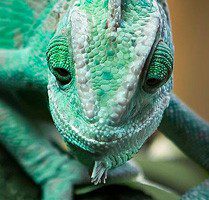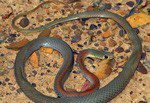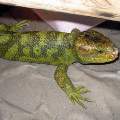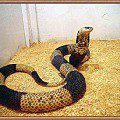
Angolan cobra
The Angolan cobra (Naja anchietae) is classified by some as a subspecies of the Egyptian cobra. But it is more correct to consider the snake as an independent species. The Angolan cobra, like the Egyptian one, has a rather spectacular appearance and an exceptionally powerful poison. In the legends of the Egyptians, it was this snake that inflicted a fatal bite on Queen Cleopatra. And it is difficult to say which of these two types of snakes is depicted on the headdress of the Egyptian pharaohs. The Angolan cobra is also used in performances by African snake charmers. And it is still unknown if they do anything with her poisonous teeth to avoid danger. The Angolan cobra owes its species name to its habitat. It is found in Angola and neighboring countries. This snake is somewhat smaller than its Egyptian relative, but they are almost identical in color. Cobras are perhaps the most common venomous snakes found in terrariums and are of great interest to study. So the Angolan cobra is also kept in artificial conditions, equipping a spacious terrarium for it and providing suitable food.
Contents
Classification
Kingdom: Animals
Type: Chord
Subtype: Vertebrates
Class: Reptiles
Order: Scaly
Suborder: Snakes
Family: Asps
Genus: Real cobras
Species: Angola cobra, Naja anchietae
Appearance
 In length, the Angolan cobra reaches about 1 meters and rarely grows larger. Its color is gray-brown, on the underside of the neck there is a dark “band”, which is especially pronounced when the snake is aggressive or frightened and inflates its hood. True, in the Angolan cobra it is not as wide as in the Egyptian. But the mechanism of its inflation is similar. It involves eight groups of muscles that lift the hood from the head, as well as the ribs. In this case, one part of the muscles is responsible for the tension of the hood, and the other – for the distribution of the load. On the head of the Angolan cobra are large eyes with a round pupil. But of greatest interest is the structure of its poisonous glands. Cobras are generally considered one of the most ancient poisonous snakes on earth. Their venom glands consist of two lobes – a main mucosa and an additional mucosa – and a secretory duct, and are more compact than, for example, those of vipers. The venomous teeth of the Angolan cobra, like all asps, are immobile and are located in front of the upper jaw. It would be correct to call these teeth poison-conducting, since a channel for poison is located inside them. And although they are paired, but the poison is injected only through one tooth, and the second is a spare. The fixed fastening of the teeth causes the Angolan cobra to open its mouth wide when biting. In addition, the snake has additional small teeth on the upper jaw behind the fangs. Due to this, the bite of a cobra leaves a characteristic imprint on the skin of the victim.
In length, the Angolan cobra reaches about 1 meters and rarely grows larger. Its color is gray-brown, on the underside of the neck there is a dark “band”, which is especially pronounced when the snake is aggressive or frightened and inflates its hood. True, in the Angolan cobra it is not as wide as in the Egyptian. But the mechanism of its inflation is similar. It involves eight groups of muscles that lift the hood from the head, as well as the ribs. In this case, one part of the muscles is responsible for the tension of the hood, and the other – for the distribution of the load. On the head of the Angolan cobra are large eyes with a round pupil. But of greatest interest is the structure of its poisonous glands. Cobras are generally considered one of the most ancient poisonous snakes on earth. Their venom glands consist of two lobes – a main mucosa and an additional mucosa – and a secretory duct, and are more compact than, for example, those of vipers. The venomous teeth of the Angolan cobra, like all asps, are immobile and are located in front of the upper jaw. It would be correct to call these teeth poison-conducting, since a channel for poison is located inside them. And although they are paired, but the poison is injected only through one tooth, and the second is a spare. The fixed fastening of the teeth causes the Angolan cobra to open its mouth wide when biting. In addition, the snake has additional small teeth on the upper jaw behind the fangs. Due to this, the bite of a cobra leaves a characteristic imprint on the skin of the victim.
Distribution and habitation
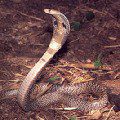 All cobras are thermophilic, so the climate of Russia is not suitable for them. Only the Central Asian cobra is found in its southern regions, while all the rest choose warmer natural zones. Moreover, in Africa, which is a fairly hot continent, there are also few cobras, since the humidity they need for life is also low there. Therefore, all African cobras try to settle near water bodies, and the Angolan cobra is no exception. It lives in tropical forests in the west of the African continent south of the equator. The preferred biotopes for the Angolan cobra are steppes, mountains, agricultural lands and even populated areas. True, she tries not to crawl into residential territory, but she can settle nearby. The main condition is that in this area there is a place to hide. Various vegetation, all kinds of ruins and stone blockages, as well as large rodent burrows are suitable for this cobra. If the Angolan cobra needs food, then it can start looking for it in a residential area, where there are many mice, rats, and also poultry. Scientists suggest that the Egyptian cobra can swim and sometimes dives into water bodies. So, perhaps, this quality is also characteristic of Angolan.
All cobras are thermophilic, so the climate of Russia is not suitable for them. Only the Central Asian cobra is found in its southern regions, while all the rest choose warmer natural zones. Moreover, in Africa, which is a fairly hot continent, there are also few cobras, since the humidity they need for life is also low there. Therefore, all African cobras try to settle near water bodies, and the Angolan cobra is no exception. It lives in tropical forests in the west of the African continent south of the equator. The preferred biotopes for the Angolan cobra are steppes, mountains, agricultural lands and even populated areas. True, she tries not to crawl into residential territory, but she can settle nearby. The main condition is that in this area there is a place to hide. Various vegetation, all kinds of ruins and stone blockages, as well as large rodent burrows are suitable for this cobra. If the Angolan cobra needs food, then it can start looking for it in a residential area, where there are many mice, rats, and also poultry. Scientists suggest that the Egyptian cobra can swim and sometimes dives into water bodies. So, perhaps, this quality is also characteristic of Angolan.
Behavior and lifestyle
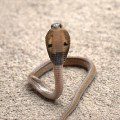 The Angolan cobra is a diurnal creature. She spends most of her time ground hunting, but sometimes she can climb trees. In extreme situations, the snake inflates its small hood. In captivity, she takes root well and does not refuse food. In winter it tends to hibernate. Angolan cobras, like Egyptian ones, are recommended to be kept in a spacious terrarium, as they are quite mobile. In relation to their relatives, these cobras often show aggression, so it is better to keep them alone, otherwise fights over food may begin, sometimes ending in the death of one of the neighbors. Angolan cobras are quite irritable and do not like to be disturbed. It is interesting to watch their clashes in the terrarium. The snakes demonstrate their superiority, trying to inflate their hood wider than that of their neighbor, and also raise their torso higher. Their attacks look like an imitation of air bites towards the enemy. And Angolan cobras, like all their relatives, bite incredibly quickly, almost lightning fast, although they can move their jaws several times before releasing the enemy.
The Angolan cobra is a diurnal creature. She spends most of her time ground hunting, but sometimes she can climb trees. In extreme situations, the snake inflates its small hood. In captivity, she takes root well and does not refuse food. In winter it tends to hibernate. Angolan cobras, like Egyptian ones, are recommended to be kept in a spacious terrarium, as they are quite mobile. In relation to their relatives, these cobras often show aggression, so it is better to keep them alone, otherwise fights over food may begin, sometimes ending in the death of one of the neighbors. Angolan cobras are quite irritable and do not like to be disturbed. It is interesting to watch their clashes in the terrarium. The snakes demonstrate their superiority, trying to inflate their hood wider than that of their neighbor, and also raise their torso higher. Their attacks look like an imitation of air bites towards the enemy. And Angolan cobras, like all their relatives, bite incredibly quickly, almost lightning fast, although they can move their jaws several times before releasing the enemy.
And although these snakes are extremely dangerous to humans, they are not as insidious as vipers, because they always warn of their presence and readiness to attack. If the threat is really serious, then the Angolan cobra attacks with several quick attacks towards the enemy and, ultimately, bites him. And yet the attack of a cobra cannot be called unexpected. Until the very last minute, she will frighten the enemy, hiss at him, make false attacks, hit her head. If the Angolan cobra happens to lose its teeth by breaking them off, then it may end up starving to death or become a victim of the mongoose, the African snake thunderstorm. When everything is calm around, the Angolan cobra can be seen basking in the sun. True, he prefers the gentle warmth of the morning, rather than a hot day.
Food
The food of the Angolan cobra in nature is quite diverse. Its victims are often small mammals, rodents, field mice, jerboas and gerbils, as well as ground birds and their chicks, various reptiles and toads and other snakes. Terrarium food is similar. However, even if the snake is full, it will still kill the animal placed in its enclosure. And in nature, the diet of the Angolan cobra is formed based on the circumstances and situation. It is interesting that due to the peculiarities of feeding cobras can be considered as a species useful to humans, because they are able to restrain the number of rodents. However, people continue to pursue and destroy these snakes, being unable to get along with them on the same territory.
Reproduction
 The Angolan cobra is an egg-laying snake. Her clutch consists of about 9-19 eggs with a characteristic parchment shell. The breeding season starts in spring. There are also courtship dances, known as snake dances, when the male pursues the female, and having caught, bends her head to the ground, wrapping her tail around. The time of “storage” of masonry in the nest lasts about 2 months. Small cobras are born poisonous and after a week, after finishing the first molt, they begin to hunt on their own. The Angolan cobra, like others, guards its clutch, but leaves the offspring before hatching. In artificial conditions, for normal reproduction, cobras often arrange wintering. However, snakes raised in captivity from birth do not require it, as they lose their seasonal breeding pattern.
The Angolan cobra is an egg-laying snake. Her clutch consists of about 9-19 eggs with a characteristic parchment shell. The breeding season starts in spring. There are also courtship dances, known as snake dances, when the male pursues the female, and having caught, bends her head to the ground, wrapping her tail around. The time of “storage” of masonry in the nest lasts about 2 months. Small cobras are born poisonous and after a week, after finishing the first molt, they begin to hunt on their own. The Angolan cobra, like others, guards its clutch, but leaves the offspring before hatching. In artificial conditions, for normal reproduction, cobras often arrange wintering. However, snakes raised in captivity from birth do not require it, as they lose their seasonal breeding pattern.
Sources of
http://dic.academic.ru/
http://www.povodok.ru/
http://ru.wikipedia.org
http://flofa.org.ua
http://uncle-doc.livejournal.com
http://aquamir.kiev.ua



